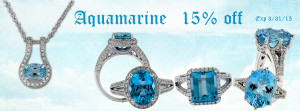
This month’s birthstone delight, aquamarine, gets its name comes from the Latin words for seawater. The stone was said to calm the waves and keep sailors safe. The tranquil quality of the blue-green gem was also thought to enhance the happiness of marriages.
Aquamarine comes from the mineral species beryl. While pure beryl is colorless, it is frequently tinted green, blue, yellow, red or white by impurities. Aquamarine’s color range is very narrow, and the best gems combine high clarity with limpid transparency and blue to slightly greenish blue hues. The gem is pleochroic, which means it shows different colors in different crystal directions — in the case of aquamarine, they’re near-colorless and strong blue. Maxixe-type, deep blue beryl is occasionally misnamed “aquamarine.”
Like many beryls, aquamarine forms large crystals suitable for sizable fashioned gems and carvings. The mineral grows in beautiful six-sided prismatic crystals that on rare occasions can be more than a foot long. While aquamarine’s smaller gems are rarely saturated enough to be attractive, stones from some of the mines in Africa, such as those found in Nigeria, Madagascar and Mozambique, are known for intense color in sizes under 5 carats.
Did you know?
The Brazilian government has been generous with aquamarine mined from its country. Eleanor Roosevelt’s 1,847-carat aquamarine was a 1935 gift from Brazil, and the center aquamarine in Queen Elizabeth’s Brazilian Tiara was a coronation gift from the Brazilian president and people in 1953.





Error thrown
Call to undefined function ereg()